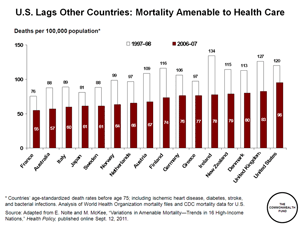New York, NY, September 23, 2011 — The United States placed last among 16 high-income, industrialized nations when it comes to deaths that could potentially have been prevented by timely access to effective health care, according to a Commonwealth Fund–supported study that appeared online in the journal Health Policy this week and will be available in print on October 25th as part of the November issue. According to the study, other nations lowered their preventable death rates an average of 31 percent between 1997–98 and 2006–07, while the U.S. rate declined by only 20 percent, from 120 to 96 per 100,000. At the end of the decade, the preventable mortality rate in the U.S. was almost twice that in France, which had the lowest rate—55 per 100,000.
 In "Variations in Amenable Mortality—Trends in 16 High Income Nations," Ellen Nolte of RAND Europe and Martin McKee of the London School of Hygiene and Tropical Medicine analyzed deaths that occurred before age 75 from causes like treatable cancer, diabetes, childhood infections/respiratory diseases, and complications from surgeries. They found that an average 41 percent drop in death rates from ischemic heart disease was the primary driver of declining preventable deaths, and they estimate that if the U.S. could improve its preventable death rate to match that of the three best-performing countries—France, Australia, and Italy—84,000 fewer people would have died each year by the end of the period studied.
In "Variations in Amenable Mortality—Trends in 16 High Income Nations," Ellen Nolte of RAND Europe and Martin McKee of the London School of Hygiene and Tropical Medicine analyzed deaths that occurred before age 75 from causes like treatable cancer, diabetes, childhood infections/respiratory diseases, and complications from surgeries. They found that an average 41 percent drop in death rates from ischemic heart disease was the primary driver of declining preventable deaths, and they estimate that if the U.S. could improve its preventable death rate to match that of the three best-performing countries—France, Australia, and Italy—84,000 fewer people would have died each year by the end of the period studied.
"This study points to substantial opportunity to prevent premature death in the United States. We spend far more than any of the comparison countries—up to twice as much—yet are improving less rapidly," said Commonwealth Fund Senior Vice President Cathy Schoen. "The good news is we know lower death rates are achievable if we enhance access and ensure high-quality care regardless of where you live. Looking forward, reforms under the Affordable Care Act have the potential to reduce the number of preventable deaths in the U.S. We have the potential to join the leaders among high-income countries."
Nolte and McKee noted that while preventable death rates declined in all 16 countries, the rate of decline varied significantly. Ireland, which ranked last with the highest preventable death rate in 1997–98, improved 42 percent by 2006–07. As a result, Ireland narrowed the gap with France, the country with the lowest "amenable mortality," with 55 preventable deaths per 100,000 people. France was followed closely by Australia (57 per 100,000), and Italy (60 per 100,000). The U.S. ranked last, with 96 preventable deaths per 100,000 in 2006–07, down from 120 in 1997–98. The United Kingdom, which like Ireland began the decade with preventable death rates higher than the United States, now has rates that are considerably lower (83 per 100,000), reflecting more rapid improvement.
According to the study's authors, the United States' poor performance and relatively slow improvement compared with other nations may be attributable to "the lack of universal coverage and high costs of care."
"Cross-national comparisons consistently find that people in the U.S. have a harder time getting and paying for the health care they need than people in other countries," said Commonwealth Fund President Karen Davis. "The good news is that Affordable Care Act reforms are targeted at specifically the areas that are responsible for this divide—costs and access to health care."


